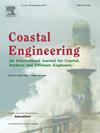An adaptive internal mass source wave-maker for short wave generation
IF 4.2
2区 工程技术
Q1 ENGINEERING, CIVIL
引用次数: 0
Abstract
The mass source wave-maker is commonly employed for generating water waves in numerical simulations, during which a correct amount of mass is introduced or subtracted from the internal flow region to produce target waves. The method has proven to be effective in producing waves in shallow and intermediate water depths, while its efficiency is declined for short wave generation. The main reason for this efficiency declination is that the internal mass source in deeper water region is not effective to generate short waves with their motions primarily on water surface. In order to overcome this shortcoming, many of the previous numerical treatments have introduced various enhancement factors into the source functions, which are empirically obtained and also violate the law of mass conservation. In this study, we develop a new adaptive internal wave-maker model that can be self-adjusted to suit different wave conditions. The line source starts from the bottom and extends to the computational cell right beneath free surface at each time step. The depth dependent weighting coefficient is introduced to the source function based on the linear wave theory for each wave component. No empirical coefficients are necessary, and the mass conservation is strictly and explicitly enforced. In principle, the method can be applied to all types of linear waves in the entire range of kh. The numerical experiments show that the present method can produce very good results for linear waves with kh up to 16.11, adequate for most of wave conditions in coastal engineering. For generation of fifth-order Stokes waves, the method can be extended straightforwardly for each of five wave components. For irregular waves composed of many linear wave components, different weighting coefficients can be readily calculated for each of them, respectively. As a result, the new model can generate irregular waves with overall better performance of reproducing wave spectrum, whose high-frequency part has been underestimated by previous methods. The numerical experiments also show that the new model can produce better results for focused waves where many linear waves of different frequencies start from the same point with specific phase angles, due to its capability of generating shorter wave components.
用于产生短波的自适应内部质量源造浪机
在数值模拟中,通常采用质量源造浪器来产生水波,在此过程中,从内部流动区域引入或减去一定量的质量,以产生目标波浪。事实证明,该方法在产生浅水和中层水深的波浪时非常有效,但在产生短波时效率却有所下降。效率下降的主要原因是深水区的内部质量源不能有效地产生主要在水面运动的短波。为了克服这一缺陷,以前的许多数值处理方法都在源函数中引入了各种增强因子,这些因子都是根据经验得到的,同时也违反了质量守恒定律。在本研究中,我们开发了一种新的自适应内部造浪模型,可根据不同的波浪条件进行自我调整。线源从底部开始,在每个时间步扩展到自由表面下的计算单元。根据线性波浪理论,为每个波浪分量的源函数引入了与深度相关的加权系数。不需要经验系数,质量守恒得到了严格和明确的执行。原则上,该方法可适用于整个 kh 范围内的所有类型的线性波。数值实验表明,本方法可以对 kh 最大为 16.11 的线性波产生很好的结果,足以满足海岸工程中的大多数波浪条件。对于五阶斯托克斯波的产生,该方法可以直接扩展到五个波浪分量中的每一个。对于由多个线性波浪分量组成的不规则波浪,可以很容易地分别计算出每个波浪分量的不同加权系数。因此,新模型生成的不规则波在再现波谱方面具有更好的整体性能,而以往的方法低估了波谱的高频部分。数值实验还表明,由于新模型能够产生较短的波分量,因此对于许多不同频率的线性波以特定相位角从同一点出发的聚焦波,新模型能够产生更好的结果。
本文章由计算机程序翻译,如有差异,请以英文原文为准。
求助全文
约1分钟内获得全文
求助全文
来源期刊

Coastal Engineering
工程技术-工程:大洋
CiteScore
9.20
自引率
13.60%
发文量
0
审稿时长
3.5 months
期刊介绍:
Coastal Engineering is an international medium for coastal engineers and scientists. Combining practical applications with modern technological and scientific approaches, such as mathematical and numerical modelling, laboratory and field observations and experiments, it publishes fundamental studies as well as case studies on the following aspects of coastal, harbour and offshore engineering: waves, currents and sediment transport; coastal, estuarine and offshore morphology; technical and functional design of coastal and harbour structures; morphological and environmental impact of coastal, harbour and offshore structures.
 求助内容:
求助内容: 应助结果提醒方式:
应助结果提醒方式:


